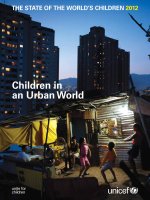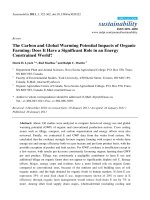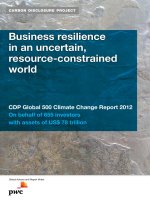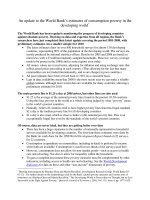Responsibility in an interconnected world
Bạn đang xem bản rút gọn của tài liệu. Xem và tải ngay bản đầy đủ của tài liệu tại đây (1.96 MB, 204 trang )
Studies in Global Justice
Series Editor: Deen K. Chatterjee
Susan P. Murphy
Responsibility
in an
Interconnected
World
International Assistance, Duty, and
Action
Studies in Global Justice
Volume 13
Series Editor
Deen K. Chatterjee, University of Utah, U.S.A.
Editorial Board
Elizabeth Ashford, University of St. Andrews, U.K.
Gillian Brock, University of Auckland, New Zealand
Thom Brooks, Durham University, U.K.
Simon Caney, Oxford University, U.K.
Hiram E. Chodosh, President, Claremont McKenna College, U.S.A.
Jean-Marc Coicaud, Rutgers University, U.S.A.
Michael Doyle, Columbia University, U.S.A.
Andreas Follesdal, University of Oslo, Norway
Carol Gould, Hunter College, U.S.A.
Virginia Held, City University of New York, U.S.A.
Alison Jaggar, University of Colorado, U.S.A.
Jon Mandle, SUNY, Albany, U.S.A.
Richard W. Miller, Cornell University, U.S.A.
Sanjay Reddy, The New School for Social Research, U.S.A.
David Rodin, University of Oxford, U.K.
Joel H. Rosenthal, President, Carnegie Council for Ethics in International Affairs
Kok-Chor Tan, University of Pennsylvania, U.S.A.
Leif Wenar, King’s College London, U.K.
Veronique Zanetti, University of Bielefeld, Germany
Aims and Scope
In today’s world, national borders seem irrelevant when it comes to international
crime and terrorism. Likewise, human rights, poverty, inequality, democracy,
development, trade, bioethics, hunger, war and peace are all issues of global rather
than national justice. The fact that mass demonstrations are organized whenever the
world’s governments and politicians gather to discuss such major international
issues is testimony to a widespread appeal for justice around the world.
Discussions of global justice are not limited to the fields of political philosophy
and political theory. In fact, research concerning global justice quite often requires
an interdisciplinary approach. It involves aspects of ethics, law, human rights,
international relations, sociology, economics, public health, and ecology. Springer’s
new series Studies in Global Justice up that interdisciplinary perspective. The series
brings together outstanding monographs and anthologies that deal with both basic
normative theorizing and its institutional applications. The volumes in the series
discuss such aspects of global justice as the scope of social justice, the moral
significance of borders, global inequality and poverty, the justification and content
of human rights, the aims and methods of development, global environmental
justice, global bioethics, the global institutional order and the justice of intervention
and war.
Volumes in this series will prove of great relevance to researchers, educators and
students, as well as politicians, policy-makers and government officials.
More information about this series at />
Susan P. Murphy
Responsibility in an
Interconnected World
International Assistance, Duty, and Action
Susan P. Murphy
School of Natural Sciences
Trinity College Dublin
Dublin 2, Ireland
ISSN 1871-0409
ISSN 1871-1456 (electronic)
Studies in Global Justice
ISBN 978-3-319-31443-3
ISBN 978-3-319-31445-7 (eBook)
DOI 10.1007/978-3-319-31445-7
Library of Congress Control Number: 2016940517
© Springer International Publishing Switzerland 2016
This work is subject to copyright. All rights are reserved by the Publisher, whether the whole or part of
the material is concerned, specifically the rights of translation, reprinting, reuse of illustrations, recitation,
broadcasting, reproduction on microfilms or in any other physical way, and transmission or information
storage and retrieval, electronic adaptation, computer software, or by similar or dissimilar methodology
now known or hereafter developed.
The use of general descriptive names, registered names, trademarks, service marks, etc. in this publication
does not imply, even in the absence of a specific statement, that such names are exempt from the relevant
protective laws and regulations and therefore free for general use.
The publisher, the authors and the editors are safe to assume that the advice and information in this book
are believed to be true and accurate at the date of publication. Neither the publisher nor the authors or the
editors give a warranty, express or implied, with respect to the material contained herein or for any errors
or omissions that may have been made.
Printed on acid-free paper
This Springer imprint is published by Springer Nature
The registered company is Springer International Publishing AG Switzerland
For Shane, Eva, Tara and Conn
Preface
Giving assistance is a widespread practice that has grown into a virtual industry.
Intended to facilitate and mediate between those in desperate need and those with a
capacity to assist, it operates at a global level, delivering assistance wherever and
whenever the need is most pressing. The practice of assistance can aim at the most
fundamental end of saving lives through the provision of food, shelter and protection, water and sanitation and medical support in times of urgent need. It can also
include longer term ends including poverty reduction, improvements in health and
education, the delivery of public services and protection of public goods, and generally a wide array of strategies intended to improve the lives and livelihoods of the
poorest members of the global community.
However, the practice is experiencing problems. Firstly, there is a growing body
of evidence that points to problems in the practical application of aid. It seems that
its instruments and activities can fail to achieve the goal of helping others and, in
some cases, have been found to contribute to harm. Secondly, this has led some to
suggest that the aid industry is in turmoil, marked by an absence of clear moral
guidelines. Why one acts to give assistance to another directly informs how one
acts. It can guide and inform which actions are permissible and, of equal significance, which actions are not permissible. It establishes the breadth and reach, the
extent and limits, of the courses of action one can undertake. However, it seems that
many within this practice are now reflecting both on their actions and their reasons
for acting, and asking if these are fit for purpose in the complex contemporary circumstances of assistance. Finally, if harm does arise in the practice of aid, the question of who ought to do what for whom to address and remediate such harm is
unclear. These problems point to important moral questions requiring a strong philosophical response.
In response to this uncertainty and unease, this book takes on the thorny task of
examining which ethical framework provides the most appropriate guide to action
for agents within the contemporary context. Of course much turns on how one
defines the term appropriate. I argue that the most appropriate framework from a
donor’s perspective is one that supports an agent to act in order to help another,
while considering the moral problem of harmful outcomes – how to avoid these,
vii
viii
Preface
how to provide redress if this is required and how to determine what responsibilities
flow from aid action. From the perspective of the aid recipient, this book argues that
the most appropriate framework is one in which aid that is required is delivered to
those most in need and that is sensitive to the social and cultural context in which it
is placed. Thus, the account of aid that is developed through these pages is one that
seeks to balance the agency of both the one in need (the recipient) as well as those
giving assistance (the donor). It seeks to move the debate beyond the question of
‘how much is enough’. Although this question is important and highly relevant in a
world marked by deep inequality and interconnection, debates on this topic typically do not extend to consideration of the practice that follows, and questions
related to what is most appropriate, who decides, how can the essential agency of
the recipient be respected through this practice and how this practice generates new
relationships and special ties between those across spatial and temporal distances
and diverse populations.
Beginning with an outline of the practical problems and context in which contemporary aid is practiced, the following chapters examine the philosophical dimensions of the problem and the claim that there is a tension between the two dominant
ethical approaches underlying this practice – principle-based deontology and
outcome-based consequentialism. To unpack this claim, it critically analyses contemporary accounts of the philosophical basis of assistance as deontological and
consequentialist respectively, against foundational accounts of the moral duty to
assist in these two philosophical perspectives, highlighting both their points of connection and conflict.
It then turns to an examination of leading accounts of the duty to aid that cut
across the philosophical traditions. These include narrow, instructive accounts that
seek to secure this moral duty through a precise specification of the act-types and
actions required; and broad, disruptive accounts that seek to provide space for more
creative and innovative expressions of this duty both within and beyond the constraints of the contemporary aid industry. It examines instructive practical applications of this duty in the work of Rawls and Singer, and argues that these accounts
fail to resolve the underlying issues and do not address the practical problems faced
by this industry. The alternative approaches of O’Neill and Sen are found to avoid
these problems in giving accounts of agency and practical reason that this duty
requires for its expression. Thus, both deontological and consequentialist approaches
can provide a basis for the practice of aid in the contemporary context, but in different ways and for different reasons. Further analysis finds that only an elaboration of
a broad consequentialist approach, elaborating on a Senian framework, can provide
a secure, practical and appropriate basis for moral action that can minimise harmful
outcomes and provide a moral basis for further action based upon the interconnections and connections generated through the act of giving.
What is termed the interconnected ethical account of the nature and scope of the
duty to assist is then developed and defended. Through an elaboration of the elements of unavoidable interconnection, responsible action, inclusive engagement
and accumulative duties and responsibilities, this approach has the potential to overcome the problems identified in other accounts and provides guidance to aid
Preface
ix
practitioners, donors and recipients in the complex contemporary circumstances of
assistance. Further, this approach sheds light on the network of moral obligations,
rights and responsibilities that can arise through the act of assisting another and
highlights the links between acting upon a duty to assist, responsibilities for these
actions and how such actions link with incremental moral duties that can amass as
a consequence of such actions.
Dublin 2, Ireland
Susan P. Murphy
Acknowledgements
Many people have helped me on this journey. But a few have taken actions, for my
benefit, and in my interest, that have enabled me to reach this point. My family have
been a source of continuous and consistent strength and support. Without their
assistance, this work would not have been possible. Special thanks to Gaye and
Sean Murphy, and also to Shane Kirwan for his inspiration, patience and unending
support. Friends and colleagues have also been incredibly helpful over the years. In
particular I would like to thank my supervisor and friend, Iseult Honohan. Her
patience, difficult questions, perseverance and encouragement were invaluable. Her
kindness and support continued to inspire and motivate me throughout this entire
process. Also, my long-standing friend and mentor, Attracta Ingram, has continued
to push and inspire me in equal measures. In particular, I would like to thank Attracta
for the late night and early morning motivational sessions. Attracta encouraged me
to take this journey. She has been there to guide me, and watch out for me, every
step along the way. Deen Chatterjee, Graham Finlay, Chris Armstrong, Brid
O’Rourke, Maire Brophy and Andy Storey also provided great support and feedback throughout the process. Many of the ideas were presented at conferences over
the past few years and I would like to extend particular thanks to members of the
ECPR International Political Theory group and the Irish Political Science
Association. Finally, thanks to the referees of Springer Series on Global Justice
whose insightful and instructive comments on the manuscript helped to improve the
project immensely; and the series editorial team, Neil Olivier and Diana Nijenhuijzen.
xi
Contents
1
2
The Assistance Industry – Crisis and Change ........................................
1.1 Introduction........................................................................................
1.2 The ‘Assistance Industry’...................................................................
1.2.1 Humanitarian Assistance .......................................................
1.2.2 Development Assistance ........................................................
1.3 Is the Assistance Industry in Crisis? ..................................................
1.3.1 Complexity.............................................................................
1.3.2 Multiplicity ............................................................................
1.3.3 Uncertainty of Outcomes of Assistance .................................
1.3.4 Implications of Complexity, Multiplicity,
and Uncertainty ......................................................................
1.4 Contemporary Circumstances of Assistance .....................................
1.4.1 Moral Dimensions: Bounded Affiliations
and the Reach of Morality .....................................................
1.4.2 Epistemic Dimensions: Need, Complexity,
Connections ...........................................................................
1.4.3 Practical Dimensions: Uncertainty of Outcomes
and Unintended Harms ..........................................................
1.4.4 Review ...................................................................................
1.5 Underlying Philosophical Problems ..................................................
1.6 Conclusion .........................................................................................
References ...................................................................................................
Contemporary Ethical Approaches to the Practice
of Assistance and Foundational Accounts of Moral Duty .....................
2.1 Introduction........................................................................................
2.2 Deontological Ethics and Assistance .................................................
2.2.1 Barnett and Snyder’s Characterisation
of Deontological Ethics .........................................................
2.2.2 Foundational Deontological Account of Moral Duty ............
1
1
3
5
9
14
15
20
22
23
24
24
25
26
27
28
30
31
35
35
37
37
38
xiii
xiv
3
4
Contents
2.2.3 Connections and Distinctions ................................................
2.2.4 Objections ..............................................................................
2.3 Consequentialist Ethics and Assistance .............................................
2.3.1 Barnett and Snyder’s Characterisation
of Consequentialist Ethics .....................................................
2.3.2 Foundational Consequentialist Account of Moral Duty ........
2.3.3 A Consequentialist Turn? ......................................................
2.3.4 Connections and Distinctions ................................................
2.3.5 Objections ..............................................................................
2.4 Tensions Between the Great Traditions .............................................
2.5 Conclusion .........................................................................................
References ...................................................................................................
41
44
46
46
47
49
51
53
55
57
58
Contemporary Philosophical Faces of Deontology
and Consequentialism – John Rawls and Peter Singer .........................
3.1 Introduction........................................................................................
3.2 Rawls’s Contractualist Deontological Account .................................
3.2.1 Background ............................................................................
3.2.2 Moral Dimensions .................................................................
3.2.3 Epistemic Dimensions ...........................................................
3.2.4 Practical Dimensions .............................................................
3.3 Singer’s (Utilitarian) Consequentialist Account ................................
3.3.1 Background ............................................................................
3.3.2 Moral Dimensions .................................................................
3.3.3 Epistemic Dimensions ...........................................................
3.3.4 Practical Dimensions .............................................................
3.4 Conclusion .........................................................................................
References ...................................................................................................
61
61
63
63
67
71
75
76
77
78
81
83
85
86
The ‘Terrible Beauty’ of Imperfect Duties – Onora
O’Neill and Amartya Sen on the Duty of Assistance .............................
4.1 Introduction........................................................................................
4.2 O’Neill’s Approach to the Practice of Ethics .....................................
4.2.1 Background ............................................................................
4.2.2 The Moral Basis of Duty .......................................................
4.2.3 Approach to Practical Reasoning...........................................
4.2.4 The Imperfect Duty of Assistance .........................................
4.2.5 Contemporary Circumstances of Assistance .........................
4.3 Sen’s Consequentialist Comparative Approach .................................
4.3.1 Background ............................................................................
4.3.2 The Moral Basis of Duty .......................................................
4.3.3 Approach to Practical Reasoning...........................................
4.3.4 The Imperfect Duty of Assistance .........................................
4.3.5 Contemporary Circumstances of Assistance .........................
4.4 Conclusion .........................................................................................
References ...................................................................................................
89
89
91
91
93
94
95
96
99
99
102
102
104
105
109
110
Contents
5
6
7
xv
Adjudicating Between O’Neill and Sen on Assistance ...........................
5.1 Introduction........................................................................................
5.2 The Moral Basis of the Duty of Assistance .......................................
5.2.1 O’Neill and the Moral Basis of the Duty of Assistance.........
5.2.2 Sen and the Moral Basis of the Duty of Assistance ...............
5.3 Practical Reasoning and Claims to Authoritative Actions .................
5.3.1 O’Neill on Practical Reason ..................................................
5.3.2 Sen on Practical Reason.........................................................
5.4 Facilitating an Action-Based Approach .............................................
5.4.1 O’Neill and the Limits and Extent of the Duty
of Assistance ..........................................................................
5.4.2 Sen and the Limits and Extent of the Duty of Assistance......
5.5 Weighing and Testing the Balance of Evidence ................................
5.6 Conclusion .........................................................................................
References ...................................................................................................
113
113
115
115
120
124
124
126
129
Defending an Interconnected Ethical Account of Assistance ................
6.1 Introduction........................................................................................
6.2 Exposition of the ‘Interconnected Ethical Approach’........................
6.2.1 Responsibility and Responsible Action .................................
6.2.2 Inclusive Engagement ............................................................
6.2.3 Accumulative Duties..............................................................
6.3 Philosophical Objections ...................................................................
6.3.1 The Charge of Misconception................................................
6.3.2 Over-Burdened? .....................................................................
6.3.3 Action Guiding or a Recipe for Inaction?..............................
6.3.4 The Problem of Agent-Based Duties:
Indeterminacy and Agent Latitude.........................................
6.4 Conclusion .........................................................................................
References ...................................................................................................
137
137
140
143
145
146
146
147
149
150
Implications for Practice & Policy...........................................................
7.1 Introduction........................................................................................
7.2 Reflecting on Real-World Cases ........................................................
7.2.1 The Haitian Cholera Crisis ....................................................
7.2.2 The Somalia Food Crisis........................................................
7.3 Agents, Actors, and Institutions .........................................................
7.3.1 Mediating Institutions and Actors ..........................................
7.3.2 Responsibility for Actions .....................................................
7.3.3 Accountability, Transparency, and Engagement
in Public Reason ....................................................................
7.3.4 Interconnecting Ethical Action: The Practice
of Just Assistance ...................................................................
7.3.5 Bridging the Gap: Linking Humanitarian
and Development Policy & Practice ......................................
7.4 Conclusion .........................................................................................
References ...................................................................................................
157
157
160
161
163
165
167
168
129
130
131
132
134
152
154
155
169
170
171
172
172
Introduction
The Idea and Promise of Assistance
Every moment of every day someone somewhere needs the help of another just to
survive. As finite, vulnerable beings, there is a time in every human being’s life
when their continued existence depends on the actions of another. Sometimes it can
depend on another simply seeing one as a human being with essential needs. When
a child cries for food, comfort or warmth, this cry is a simple statement that they are
a human being in the world and need another to help them to meet some requirement. When an adult calls on another for help they themselves know what they
need, but they are unable, for any variety of reasons, to provide this for themselves
and so call upon another to help them to meet this need.
Assistance, both giving and receiving, is part of the material and social fabric of
all finite lives. Assistance here means, quite simply, acknowledging another’s status
as a human being and acting for their benefit or in their interest at some point in their
life.
Life is precarious and uncertain. Accidents happen and natural events occur.
These are matters of sheer brute luck to which every human being, as a finite, vulnerable, ecologically embedded and interconnected entity is exposed. However, for
many, the probability of harm and the risk of exposure to suffering are greatly
increased by the fact that they were born into one state rather than another, or one
community rather than another, or indeed one sex rather than another.
In our world, life expectancy, infant mortality rates, access to adequate health
care, access to education, death from preventable disease, risk of exposure to disaster and so on are all linked with what is sometimes referred to as ‘the accident of
birth’ – where one happens to be born, the capacities one happens to be born with
(or without), the parents one happens to have and the social and political culture that
one is born into.
Focusing on luck might easily overlook important underlying dimensions of the
real world and the complex and multi-faceted reasons where some need more assistance than others to meet their essential needs. In many cases, it is not luck that
xvii
xviii
Introduction
explains why some need assistance during the course of their lives. To borrow a
distinction employed by Jean Jacques Rousseau, there are cases where assistance is
required due to natural facts and events; however, other cases are due to artificial or
social events.1 All populations are exposed to non-predictable external shocks,
including economic and environmental events, and risks such as ill-health, that can
lead to loss of livelihood and a descent into economic poverty for various durations
of time.2 In spite of this, the majority of the global population continue to experience weak and incomplete government provided social protection systems and are,
therefore, at risk of a descent into poverty of various durations at any time.3
In 2011, 75 % of the global population lived without social security and social
protection supports. In less developed countries and regions, in the absence of such
supports, individuals and households must develop coping strategies at a micro level
to deal with both natural and social contingencies. Thus, exposure to shocks, even
minor shocks such as an ill-health or a temporary loss of employment, leave the
majority of the global population in a state of material insecurity and vulnerability
and, to varying degrees, at risk of descent into poverty. When examining norms and
practices of international assistance analogies to cases of single individuals in
urgent need, such as a drowning child in need of rescue, do not easily or obviously
correspond to the systematic harm and systemic risks faced by hundreds of millions
of individuals on a daily basis.
Scenes of complete devastation and unimaginable levels of suffering are ubiquitous enduring features of the human condition as finite vulnerable beings, ecologically and socially embedded in complex mutable systems. However, the
contemporary context is markedly different from that of previous generations in at
least two fundamental ways. Firstly, the human population has never been larger
with the highest growth rates in the lowest income least developed locations. Those
most exposed to random social, economic and ecological changes and shocks tend
to have the least resistance with low social protection systems and thus are more
likely to require higher levels of international aid into the future. Secondly, the technology revolution ensures that when any person, anywhere in the world, experiences harm and suffering, for the first time in the history of humanity, anyone with
access to a computer, phone or any form of modern media can know this, witness
this directly and indeed act to assist that one in need.
To ease some of this suffering and address some of the most basic requirements,
practices of assistance have evolved and expanded over recent centuries. The sight
of thousands of human beings standing in line to receive food provided by others or
risk death from starvation is not unusual or extraordinary in the twenty-first century.
Nor is the sight of hundreds of thousands of human beings living together in tents
1
See J. J. Rousseau A Discourse on the Origin of Inequality (1973: 49) for use of this distinction
in his analysis of inequality.
2
Word Bank Development Report (2014) documents the extent that global populations are vulnerable to such risks.
3
ILO (2014) report that only 27 % of the global population have access to comprehensive social
security systems; See Murphy and Walsh (2014) on poverty flows.
Introduction
xix
and camps because something has happened to drive them from their homes. Some
event, or complex blend of interacting factors, has occurred that has interrupted
their regular patterns of daily living. These camps are intended to provide immediate help or relief for those who need this. However, it is not unusual for such camps
to become homes for extended periods of time as groups are often unable to return
to their homes and ancestral lands for any number of reasons. In 2014, UNHCR and
the Norwegian Council for Refugees estimate that in excess of 50 million human
beings were displaced from their homes and in need to urgent assistance.4 This trend
has continued to increase with over 60 million human beings displaced at the end of
20155 and is likely to continue for a variety of reasons including conflict over ever
decreasing natural resources and changing climates.
In practice, governments and citizens in all states accept that they ought to help
others (governments, states, citizens and people) in dire need and life-threatening
situations. We see this acceptance in the foreign aid programmes of national governments which see disbursements of financial and technical assistance to dozens of
low and middle income countries each year.6 States also collaborate to respond to
humanitarian crises beyond their borders caused by natural events and sociopolitical human-made events wherever these occur. Examples of large-scale international responses to natural events include the earthquakes in China (2009), Haiti
(2010) and Japan (2011); and socio-political human-made events in diverse geographies including Yemen, Syria, South Sudan, The Central African Republic (CAR)
and the Democratic Republic of Congo to name but a few. They also cooperate in
the development and maintenance of a shared international policy framework coordinated through the United Nations and overseen by various international intergovernmental organisations and policy bodies.
In response to known suffering and harm, billions of dollars are pledged7 from
those with the capacity to assist to those in desperate need in the form of what is
known as humanitarian and development assistance. As the needs of so many are so
great in our world, this assistance is mediated through an international institutional
framework consisting of a wide range of actors from state-based organisation to
non-governmental organisations.
The practice of assistance, and the international institutional framework and
policy architecture, is divided into two core domains. Humanitarian assistance is
assistance that provides urgent relief to those at risk of death. It typically aims at
saving lives through the provision of basic necessities including water and sanitation,
4
/> />library/Media/201505-Global-Overview-2015/20150506-global-overview-2015-en.pdf accessed
10 May 2015.
5
Accessed 22 December 2015.
6
See OECD DAC statistics site for information – />cs?cr=302&cr1=oecd&lg=en&page=1
7
Although billions of dollars are pledged by donor countries, it is not unusual for a long delay in
the actual transfer of funds to occur. For example, in the case of Haiti, 1 year after the event the
international community had managed to transfer only half of pledges for 2010 according to a
report from UN Office of the Special Envoy for Haiti in June 2011.
xx
Introduction
shelter and protection, medical care, food and so on. The second domain is the
wider and more ambitious domain of development assistance. This form of assistance is much more far reaching in its objectives.8 Development aid is typically
provided over longer periods of time to assist states, people and populations to
develop sustainable living conditions.
The year 2015 witnessed the introduction of a new aid architecture and policy
framework in both domains. Within the humanitarian space, the Sendai Framework
for Disaster Risk Reduction (March 2015) was agreed among international intergovernmental actors to success the Hyogo Framework. Within the development
space, the Sustainable Development Goals Framework (September 2015) was
agreed to follow from the Millennium Development Goals and Millennium
Declaration. In parallel with these developments, changes were also agreed to the
global climate governance regime with agreement on the framework of an international response to tackle anthropogenic climate change through the Paris Agreement
(December 2015).
The organised practice of humanitarian assistance began as a response to the horrors of war and the harm and suffering of civilian populations. The origins of this
practice are often traced to the work of Florence Nightingale during the Crimean
War (1863) and the establishment of the International Red Cross and Red Crescent
movement by Henry Dunant (1863).
However, humanitarian assistance is not restricted to the domain of war. It is also
provided to groups who have experienced natural shocks and are exposed to physical, biological and technological hazards where large numbers of human beings are
temporarily displaced and their very survival is threatened. Humanitarian assistance, as described by Jennifer Rubenstein, ‘involves the provision of goods and
services such as food, water, sanitation, medical care, shelter, and (sometimes) protection, during and soon after natural and man-made disasters’ (Rubenstein 2007:
292). The core stated objective of this assistance is to save lives and to restore an
affected group to their pre-emergency state.
Development assistance, on the other hand, is concerned with supporting states,
people and populations in the development of sustainable living standards and conditions. Again, as Rubenstein outlines, development assistance aims at supporting
the provision of longer-term social services and infrastructure, including ‘the funding of education, health and population programs and so on’ (Rubenstein 2007:293).
Development assistance has traditionally entailed transfers of aid from richer states
(traditionally referred to as ‘developed states’) to poorer states (referred to as ‘developing states’/‘low income locations’). Practices of development assistance have
changed over time. Initially targeted towards economic growth in the 1950s, development assistance shifted and broadened its objectives to include improved human
outcomes within a human development approach emerging in the 1990s. This
approach entails activities targeting improved health and education outcomes for
the poorest populations in the world, in addition to economic growth. From 2015,
8
See the Sustainable Development Goals agenda that will guide the international development arena
from 2015 to 2030 – />
Introduction
xxi
the target of development assistance will shift again towards ‘sustainable development’. According to Sachs (2015: xiii), sustainable development can be understood
as an analytical concept entailing consideration of a wide range of intersecting factors including social, economic, and environmental and governance dimensions.
Sustainable development is concerned with meeting the needs of present generations without jeopardizing the ability of futures generations to meet their own
needs.9
Since the second half of the twentieth century, there has been significant growth
in the number of organisations and institutions engaging in the practice of assistance
(Barnett 2011; Riddell 2007). These include intergovernmental and international
organisations (IGOs and IOs), national and international non-governmental organisations (NGOs and INGOs) and civil society organisations (CSOs). This growth
has coincided with increases in funding from public sources (in the form of donations from states through the public tax purse) and private sources (in the form of
donations from individuals and private institutions and corporations). The first
decade of the twenty-first century saw a steady expansion of Official Development
Assistance (ODA) with the total amount of aid provided by OECD countries
exceeding $100 billion USD for the first time ever in 2005. This represented a doubling of ODA from 2001 figures and has continued this upward trajectory in spite of
the global financial crisis in 2007/2008. The year 2015 witnessed a continued
increase with ODA now exceeding $135 billion USD. However, in spite of this
increase, unacceptably high levels of extreme poverty and deprivation persist, and
the numbers of those in need of urgent humanitarian assistance continues to rise.
According to World Bank development reports and the Millennium Development
Goals (MDG) reports, the first goal to halve the proportion of people living in poverty by 2015, where poverty is measured as the proportion of the population living
below $1.25 purchasing power parity (PPP) per day, has been achieved. However, a
further billion people remained below the poverty line at the end of this period
(2015). While poverty rates are declining the concept of the bottom billion survives.
At the beginning of the MDG project, the bottom billion entailed one in six people
globally. By the end of the period, the bottom billion represented approximately one
in seven people living in extreme poverty and thus remains a pressing problem and
focus of concern for the foreseeable future.
According to the 2013 report from the UN High Level Panel of Eminent Persons
developed to inform the post-MDG/2015 discussions, A New Global Partnership:
The next development agenda must ensure that in the future neither income nor gender, nor
ethnicity, nor disability, nor geography, will determine whether people live or die, whether
a mother can give birth safely, or whether her child has a fair chance in life. (2013, p. 7).
Thus, the need for aid and assistance is high, but the commitment of the international community seems strong. According to the UN High Level Panel of Eminent
Persons report (UN HLP 2013), the post-2015 development agenda requires five
9
Definition given in the Brundtland Report ‘Our common future’ of the World Commission on
Environment and Development (WCED), adopted in the Framework of the United Nations.
xxii
Introduction
transformative shifts: (i) leave no one behind; (ii) put sustainable development at the
core; (iii) transform economies for jobs and inclusive growth; (iv) build peaceful
and effective, open and accountable institutions for all; (v) forge a new global partnership on the basis of solidarity, cooperation and mutual accountability – ‘a new
partnership should be based on a common understanding of our shared humanity,
underpinning mutual respect and mutual benefit in a shrinking world’ (UN HLP
2013: 3–4).
To many, it might seem as though practices of international assistance represent
a zenith in the history of humanity whereby groups of human beings can give and
receive assistance to one another across great distances and national boundaries.
Further, the international rhetoric regarding global responsibilities and solidarity
has perhaps never been louder. However, a closer examination of this area would
suggest that all may not be quite as rosy as it seems, or indeed, as many would hope.
Events and trends which began to emerge over the closing decade of the twentieth century have cast a shadow over some of these practices. The complexity of
event types and the recurrence of the need for assistance in certain locations and
among certain populations have been taken by some to indicate that all is not well
with contemporary practices of assistance. It seems that, in many cases, the practice
of assistance is struggling to achieve the ends at which it is aimed. The resurgence
of famine in the Horn of Africa in 2011, a region that has been a beneficiary of
multiple assistance efforts over the preceding decades, is an indication that all is not
well. Further, escalating conflict across a range of diverse regions and geographies
from Somalia to Yemen and Burundi represents a major reversal of development
achievements. Indeed, these events point to an obvious question – what is going
wrong with the practice of assistance?
Parallel to the growth in the practice of assistance, a burgeoning body of empirical research and literature has emerged which examines these practices. This
research is concerned with practical challenges faced by donors, beneficiaries and
the mediating organisations that connect these groups. Uncertainty and unease that
all may not be well with this practice has fed into debates within this literature also.
There are two elements to these debates, practical and moral. Firstly, there is a quandary concerning which instruments of assistance actually work, and more problematically, what happens when instruments do not work. Secondly, and related to this,
there are concerns relating to apparent tensions between the dominant ethical
approaches underlying this practice, and what appears to some to be the absence of
clear moral guidelines.
On the first point, there is a multiplicity of instruments of assistance. However,
there is much disagreement concerning which ones actually work and achieve the
ends at which they aim. Underlying this debate is a growing unease that some
instruments may not only be failing to achieve their intended goals, but may actually be contributing to harm.10 This unease has been compounded by a number of
high profile cases taken to the courts by ‘aid recipients’ seeking legal remedy for
10
See for example, Riddell (2007), Ramalingam (2013), Easterly (2008) and Moyo (2009) for
analysis and explanations concerning aid and its contribution to harm and suffering.
Introduction
xxiii
harms they experienced during the assistance process – these include the Haitian
Cholera Case11 where members of the Haitian community took a case against the
UN following an outbreak of cholera in the region that was linked to sanitation
practices of UN soldiers following the 2010 earthquake, and a case taken by
Ethiopian farmers against the villagisation projects funded by the World Bank and
the UK Development agency (DFID).12
However, there are also underlying moral and philosophical problems evident
within the empirical literature. In many cases it seems that practitioners are experiencing, at a very basic level, severe difficulty in determining what is the right action
to take that can provide essential assistance and at the same time avoid contributing
to further harm. According to a wide number of analysts, there are two main ethical
approaches employed by those engaged in the practice of assistance to support them
in determining what the right action to take would be in particular contexts. These
are ‘principle/duty-based’ or deontological approaches whereby practitioners act in
accordance with a set of defined principles or duties, and ‘outcome-based’ or consequentialist approaches whereby practitioners act to achieve certain outcomes and
promote certain values.13
It seems that the actions of those who are guided by a specific set of principles
(duty-based action) can, and often do, result in unintended harms. Quite who ought
to do what for whom when harm arises is unclear. Examples include experiences of
ongoing violence and suffering within humanitarian camps in the Democratic
Republic of Congo and Sudan, and instances where food aid can result in interference in local modes of food production leading to increased food insecurity
(Ramalingam 2013). However, it also seems that those acting to achieve particular
outcomes or ends (outcome-based action) are finding that those outcomes are more
difficult to achieve then they had assumed and again may result in more harm than
good. Examples include instances where aid distribution systems can only be sustained through direct pay-offs to warring parties, thus potentially and inadvertently
contributing to a pro-longing of conflict; where urgently required food and medical
supplies are usurped and used as currency to gain power and control; or where vulnerable members of a community are intentionally exploited to gain international
attention and thus, international humanitarian aid.14 There are also many examples
of slowly occurring problems such as aid dependency where ongoing aid transfers
for the provision of public goods and services can lead to increased dependency
amongst recipient populations and their governments (Easterly 2008; Riddell 2007).
So it seems that neither duty-based reasoning (deontological) nor outcome-based
11
/> />13
This observation is made by analysts such as Michael Barnett (2008, 2011), Thomas Weiss
(1999), Richard Shapcott (2010), Ben Ramalingam (2013) and Roger Riddell (2007).
14
See for example Ricardo Pollack’s (2012) Documentary ‘The Trouble with Aid’ accessible at
/>12
xxiv
Introduction
reasoning (consequentialist) can confidently guide actions when the need for assistance arises, at least as they are currently practiced.
This raises important moral questions. Why one acts to give assistance to another
directly informs how one acts. It can guide and inform which actions are permissible and, of equal significance, which actions are not permissible. It establishes the
breadth and reach, the extent and limits, of the courses of action one can undertake.
However, it seems that many within this practice are now reflecting both on their
actions, and their reasons for acting, and asking if these are fit for purpose. The
circumstances are complex and the outcomes of assistance can be uncertain.15
Indications of concern among policy makers surrounding contemporary practices
can be found in the ongoing discussion fora on Aid Effectiveness in the realm of
development assistance (Paris 2005; Busan 2011),16 and the emergence of new bodies focusing on accountability and transparency within the humanitarian sphere,
such as the Humanitarian Accountability Partnership (HAP).17 What seems to be
emerging from these policy debates is that although international aid flows are capital flows and as such, directly influence the life of a recipient and their surrounding
communities, there are concerns surrounding accountability and responsibility for
outcomes, and answerability for harms or wrong-doing arising from these financial
flows. Further, this flow is not widely subjected to moral evaluation, critical scrutiny, or formal regulation and systematic evaluation. Thus, these issues raise important moral questions requiring a strong philosophical response.
Moral philosophy has also seen an eruption of debate and interest concerning the
matter of assistance paralleling the growth in the practice of assistance. In response
to the preventable suffering and harm experienced by millions of human beings in
East Bengal (1971), Peter Singer published a seminal article that sparked an avalanche of debate in moral philosophy. Singer’s message is clear, concise, intuitive
and simple. He wrote, ‘as I write this, in November 1971, people are dying in East
Bengal from lack of food, shelter, and medical care. The suffering and death that are
occurring there now are not inevitable, not unavoidable in any fatalistic sense of the
term. Constant poverty, a cyclone, and a civil war have turned at least nine million
people into destitute refugees; nevertheless, it is not beyond the capacity of the
richer nations to give enough assistance to reduce any further suffering to very small
proportions’ (Singer 1972: 229). Many people, as they watch contemporary tragedies unfold on their television screens, share similar thoughts.
There is widespread agreement in this philosophical debate with the general normative claim that one should act to alleviate the suffering of another if one has the
capacity to do so. This is referred to as a moral duty to assist that is incumbent on
all human beings in their capacity as agents simply qua moral agents.18 However,
there is strong disagreement on why one ought to do this and what this would entail.
15
See for example William Easterly (2014, 2008), Moyo (2010) and Barnett and Weiss (2008).
/>17
/>18
This broadly implies that a human being has the capacity for thought, choice, deliberation and
action.
16









